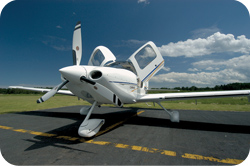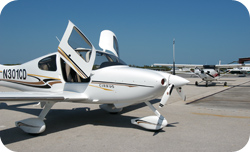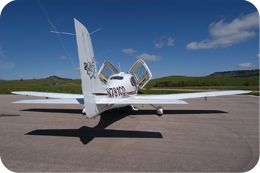| |
|
|
|
| |
INTERVIEW with a CIRRUS DESIGN ENGINEER
 To explain the evolution of and theory behind the CIRRUS wing,
we’ve conducted an interesting and candid Q&A with one
of the company’s topdesign engineers. What follows is a discussion
on the revolutionary design of the CIRRUS aircraft wing, the CIRRUS
commitment to safety by reducing stall/spin accidents, and the
overall engineering philosophy at CIRRUS. To explain the evolution of and theory behind the CIRRUS wing,
we’ve conducted an interesting and candid Q&A with one
of the company’s topdesign engineers. What follows is a discussion
on the revolutionary design of the CIRRUS aircraft wing, the CIRRUS
commitment to safety by reducing stall/spin accidents, and the
overall engineering philosophy at CIRRUS.
Question: Can you tell us the strategy behind the CIRRUS
wing design, and what makes the wing unique?
CIRRUS Engineer: When the engineering team at CIRRUS
looked at the hard accident data, what we found was that the
vast majority of spins takes place one-thousand feet above
ground level and below. What this means, is that at such a
low altitude to begin with, few pilots can recover from a stall
or stall/spin before an impact with the ground. With most of
the accidents initiating at or below 1,000 feet – and
with recovery taking on average 1,200 feet – it became
obvious that making a plane easy to recover from a spin, and
then training the pilot group in spin recovery, is not enough
to solve the vast majority of the stall/spin accidents because
there simply is not enough altitude to recover. Most of these
events are occurring during the take-off and landing phase
of the flight, so it seemed much more logical to concentrate
our efforts at CIRRUS at preventing spins in the first place.
Question: What are the features of the CIRRUS that aid
in preventing a spin?
CIRRUS Engineer: If you can prevent either the stall
from occurring, or have full control authority in the stall,
you can essentially eliminate the possibility of going into
a spin. If you can do this, then there is less concern about
the altitude necessary for recovery, because the pilot can
recover the airplane normally and avoid the stall from entering
a spin.
With that in mind, it was back in the 1960’s that NASA began a significant
program to improve the stall/spin accident problem and it was spearheaded
by two folks – one of them Jim Patent – an original Cirrus Design
test pilot, who also worked as Chief Test Pilot for the NASA-Langley research
center. Together, Jim and his partner investigated numerous approaches to
avoid loss of roll control in a stall. The result of their research was the
leading edge cuffs that you now see incorporated into the leading edge of
the CIRRUS wing.
Leading edge cuffs are simple and effective, and have very little degradation
on cruise speed and performance. But, like all good solutions, there are
certain compromises.
Question: Then why use the droop design?
CIRRUS Engineer: The slow flight regime of flight, if
I’m like most pilots, is probably something I rarely
practice becoming proficient in. Yet, I’m supposed to
remember that throughout the regime of slow flight I’m
to use the rudder to control roll, rather than aileron. The
problem is, I’m used to using aileron input to control
roll. Now one day I find myself in a slow flight condition,
and I use aileron to try and maintain roll control. When I
do that, the aileron goes up on one wing surface, but down
on the other, and that situation exacerbates the increased
drag that I’m already experiencing.
This can create quite a confusing condition and I end up cross-controlled,
and if the slow fight progresses to a stall, then I enter the stall uncoordinated
and could enter an inadvertent spin. Because we generally use ailerons to
turn for the majority of our flying, the idea of using rudder to maintain
roll control becomes counter-intuitive to the pilot, so he just keeps on
using aileron. If he then stalls near the ground, whether or not it progresses
to a spin, his chances for recovery are slim.
Question: Why is it so difficult for pilots to recover?
CIRRUS Engineer: Many factors, including the basic one
that you need a certain amount of altitude to recover from
a spin and 1,000 feet in most cases is not enough. But beyond
that, you have the element of fear and surprise which will
cause most pilots to probably panic and do the wrong thing.
Case in point, I’m an aerodynamic engineer by trade, but I’m
also a pilot. Years ago I was doing stall training in an older model high-wing
trainer and I accidentally went into an inadvertent spin. During my stall
practice, I had been trying to use the rudder to control my roll axis, but
a wing ‘fell off’ to one side, putting the airplane into an incipient
spin. We were three-quarters of the way around before I basically took a
50/50 guess on which way to jam the rudder. I had no idea which way we were
spinning, because the entire spin caught me by surprise in the first place,
so that event proved to me first-hand that when you’re surprised by
a spin, even knowing something as basic as which direction you’re spinning
may be too much to expect. Obviously, not being certain of the direction
of rotation is going to hamper a successful recovery.
Additionally, spin training tends to be woefully inadequate as the majority
of CFI’s have had only the most rudimentary instruction themselves
and may have actually completed only a single spin in either direction, which
does not prepare them to be experts in providing spin instruction. The average
CFI is looking to build time and move on, so this probably isn’t his
strong suit.
Question: So where does the leading edge cuff entere
into the equation?
 CIRRUS Engineer: Cuffs allow the pilot to control the
wing as you would in any other phase of flight. The name of
the game is maintaining control in an approach to a stall and
even into the stall, so as to avoid the violent wing ‘fall
off’ that occurs in many airplanes with traditional wing
designs. CIRRUS Engineer: Cuffs allow the pilot to control the
wing as you would in any other phase of flight. The name of
the game is maintaining control in an approach to a stall and
even into the stall, so as to avoid the violent wing ‘fall
off’ that occurs in many airplanes with traditional wing
designs.
Additionally, different airplanes have different – what we call – ‘gotchas’ in
spins, and also different spin recovery techniques. In many planes the procedure
is to stop the rotation and then either relax and/or apply forward pressure.
This is to be done while holding neutral aileron, and with the throttle in
the idle position. But, some planes are different. In those cases you have
to break the spin by pitching forward first and then apply rudder to stop
the rotation. In other words, if you go rudder first and then wait for the
rotation to stop, you’ll wait all the way until impact because you
have to break the stall first. Other airplanes are so docile that if you
just let go of the controls, the plane will generally recover on its own.
But again, since most of these fatal stall/spin accidents are occurring at
pattern altitude, the recovery process almost becomes a moot point as there
simply is not enough available altitude left. That’s why we believe
that prevention is the cure, and the droops help to prevent the loss of control
that gets pilots into trouble.
Question: Has any spin testing been conducted in the
CIRRUS airplanes?
CIRRUS Engineer: Yes, CIRRUS has done spin testing in
both the SR20 and the SR22, and we’ve done a variety
of spins in both models. But, that’s different than saying
we’ve completed the entire spin matrix in each plane
in every conceivable condition and configuration – because
we haven’t. Eventually we decided to take the logical
stand that spin prevention is the key to preventing needless
fatalities, and attempts to make the airplane spin-certified
would just muddy the waters.
Spin recovery requirements are very stringent. The upside of the cuffs – that
they give greater control in the slow flight regime – also have, like
every aircraft feature, a compromise, and that is that they can cause an
aircraft to take more than the required one-turn recovery rotation to be
eligible to be spin-certified. But people should understand that even though
an airplane may be spin certified, certain ‘cliffs,’ as we call
them, can still exist in spin aerodynamics making recovery uncertain.
Question: Can you give us an example?
CIRRUS Engineer: Sure. There was a plane that was being
developed and certified for spins that was demonstrating fairly
straight-forward recoveries. Then one day a condition occurred
where it took two full turns to recover from the spin, but
certification standards clearly say you need to do it in one
turn. The test pilot conducted spin after spin in that condition
trying to improve the technique to get the recovery down to
that one turn.
Question: What happened?
 CIRRUS Engineer: He made some progress. He got it down
to one-and-a-half turns. Then on the 30th attempt, the spin
was entered into with a greater yaw rate and it entered an
unrecoverable spin. Fortunately the test pilot was wearing
a parachute and he successfully bailed out. What this means
is that even test pilots will find the condition that a plane
will not recover from – the cliff – and sometimes
it comes down to how fast the plane initially slices into the
rotation with the yaw rate. CIRRUS Engineer: He made some progress. He got it down
to one-and-a-half turns. Then on the 30th attempt, the spin
was entered into with a greater yaw rate and it entered an
unrecoverable spin. Fortunately the test pilot was wearing
a parachute and he successfully bailed out. What this means
is that even test pilots will find the condition that a plane
will not recover from – the cliff – and sometimes
it comes down to how fast the plane initially slices into the
rotation with the yaw rate.
Question: Why does yaw rate matter so much?
CIRRUS Engineer: Think about it. The faster you spin
anything up, the harder it is to stop it. The greater momentum
you have entering a spin, the more energy there is to get it
into rotation and thus the more energy you need to stop it!
The downside of spin resistance is that the more resistant
a wing is made to stall and spin, the more difficult it can
be to recover from an actual spin if you let it get that far.
Prevention is key.
These accidents happen mainly because the pilot loses control at low altitude,
and the bottom line is this: if you’re so distracted or you’ve
so lost situational awareness that you’ve lost control of your airplane,
what possibly makes you think that you’re going to suddenly be sharp
enough to bang out an effective and instantaneous correct spin recovery?
Our decision at CIRRUS was based on prevention versus recovery, and I believe
there’s a case to be made that without the drooped wings, there would
be more stall/spins fleet wide. As of this date, we have not had a single
low altitude stall/spin accident.
Question: Can you give an example of how the drooped
wing works in real life?
CIRRUS Engineer: During the takeoff or landing phase,
pilots can sometimes inadvertently get too slow. In these cases
they might notice the stall warning going off, and even a buffet,
but the plane doesn’t roll off – they’re
able to maintain control – and the whole thing is sort
of a ‘non-event.’ Instead of an accident, it becomes
a ‘lesson learned’ to the pilot. If the wing had ‘rolled
off,’ most likely he would have become another fatal
accident statistic. The hope and the goal is that the end result
will be that the droop does what it is designed to do – stop
little incidents from becoming accidents. We see our mission
as to help protect your wing roll control throughout the slow
flight regime to prevent that sudden drop and loss of control.
Question: What are the limits?
CIRRUS Engineer: There are limits to everything, including
a so-called ‘spin recoverable’ airplanes ability
to recover under all conditions. Of course there are limits
to our droops ability to prevent a roll-off. If you really
get it into a full stall, you can push it beyond its ability
to protect – nothing is completely foolproof. My advice
to pilots wanting to practice stalls is to consider working
with an instructor and going about this in the safest manner
possible by starting inside the known envelope and then creeping
towards the edge. Start in a known flight regime, and then
gradually work into stalls. Don’t play test pilot, because
at some point you will succeed in your request to see what
it takes to get it to roll over – you will find that
point.
I’d like to stress that the FAA was very impressed with Cirrus Design’s
ability to protect the pilot in the stall regime. And again – we can’t
stress this enough – what saves lives is avoiding getting into an inadvertent
stall in the first place.
Question: What role does the parachute or CAPS (CIRRUS
Airplane Parachute System) play in all of this?
CIRRUS Engineer: Since at CIRRUS we made the judgment
call to not certify the airplane in the spin category, we still
recognized that even with the added safety of the drooped wings,
the possibility still existed that a pilot could find himself
in a situation where he has gotten the airplane into a spin.
In that case, the CAPS can be deployed for a quick recovery,
slightly less than 1,000 feet if immediately activated.
The parachute has a connection to spins in that if you get into one, it is
the means of recovery you should use. In tests we conducted, in a one-turn
spin the chute will recover you faster than will the standard pilot control
input. But, the parachute’s purpose is not limited to spin recovery,
it’s there to give the pilot an option in a number of emergency scenarios
such as total engine failure, mid-air, control failure, etc.
We want pilots to keep in mind that they should be ‘primed to pull.’ In
the early phases of the military ejection seats it was found that pilots
would stay with a broken or spinning aircraft all the way until impact, rather
than pull the ejection handles. Why? Because the decision to eject was not
yet firmly planted in their minds. Initially the seats were not a success
because there was not the collective recognition by the pilot group to eject,
and the military had to conduct a lot of additional training to overcome
the mindset to ‘save the plane.’
The F-14 Tomcat worked well in this respect because it’s usually the
back-seater, the RIO, who pulls the ejection handles first. Because he’s
not fixated on the flight controls, he can more easily sum up a bad situation
and say, “hey – I’m outta here!”
So we hope that CIRRUS pilots will instinctively have it in their mind that
what they’re going to do if they should ever find themselves in a spin
scenario is to pull the chute. Again, if the situation warrants, be primed
to pull.
This concludes the CIRRUS Stall/Spin Awareness article series. Thank you
for reading and look for a new safety series to be presented on this site
in the near future.
|
|


|
|
|

